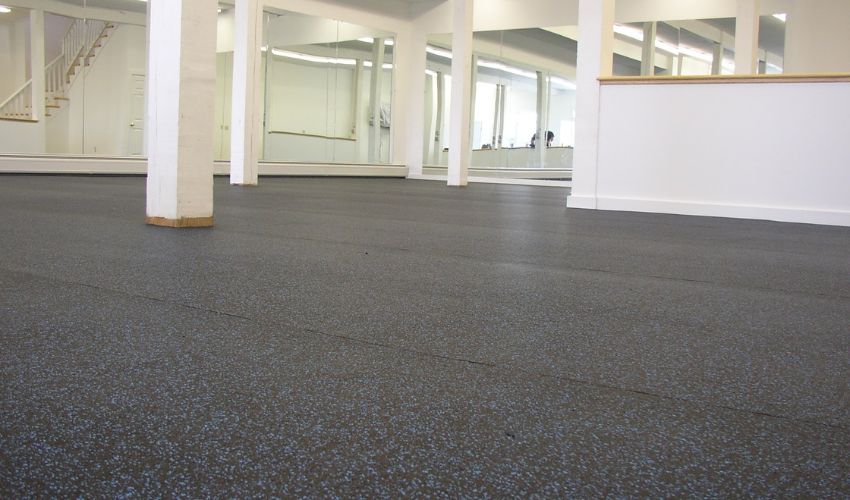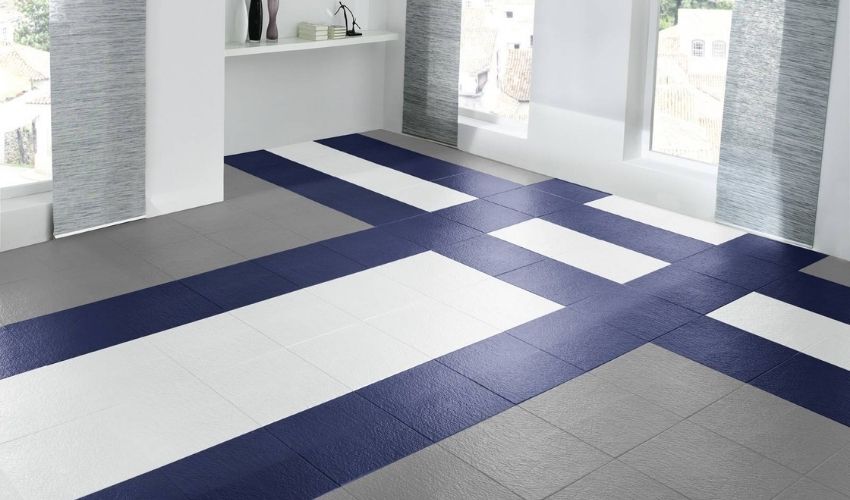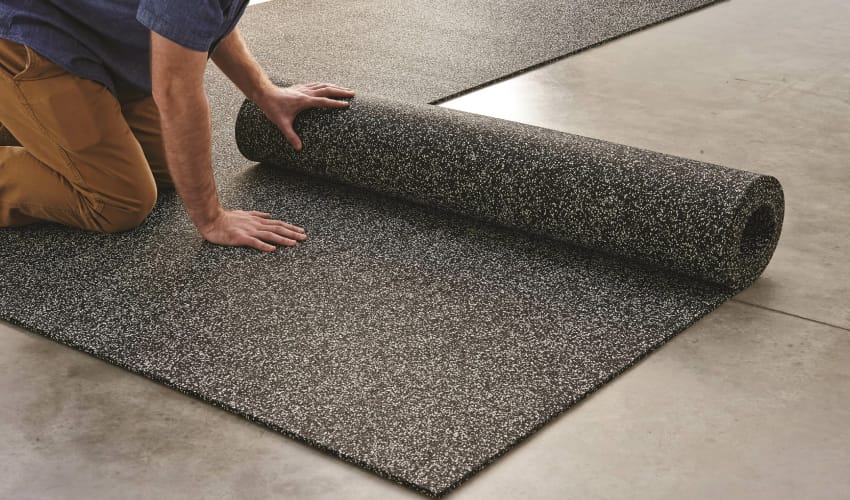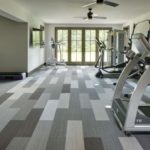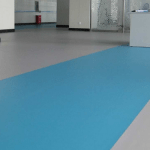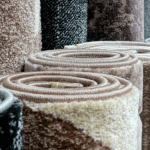Rubber flooring is the ideal all-rounder floor treatment that works wonders for nearly every space. Other than its wide applications in fitness and sports facilities, it makes an excellent choice for residential interiors, particularly moisture-prone ones. Speaking of such spaces, they are mostly kitchens, bathrooms, laundry rooms, and home basements.
This leads us to our topic of debate today at Fixit Design: the selection of rubber flooring for basements. This flooring is a beyond-useful option for basements, almost always prone to factors like groundwater damage, temperature changes, and impact effects. It can effectively eradicate all these problems while remaining serviceable extensively.
Choosing Rubber Flooring For Basements
Of course, all the benefits of this natural flooring in a basement setting depend on an accurate selection. If you’re new to this, we’ve got a handful of help so you can make the most of your investment and have maximum peace of mind.
1- Utilization Level
The primary aspect you need to consider while deciding on suitable rubber flooring is that it must keep up with the extent of your basement’s usage. In other words, the flooring type you’ll need will vary with how much the area gets used, or you can also consider foot traffic.
For instance, if you use your basement a lot, you must use thicker flooring. In the same manner, thin, modular, and lightweight interlocking mats will work fine if your basement is just another regular room in your place and no excessive activity goes on.
2- Usage Nature
This one is somewhat similar to the factor discussed earlier, except that we’ll discuss the nature of your basement activities. If you use your basement for high-impact activities like workouts or simply for dumping furniture or other heavy items, it needs a hard-wearing treatment like rubber tiles that are 30 to 40 mm thick.
Meanwhile, in case of moderate usages such as resting, entertainment, or similar stuff, you can go with flooring up to 8 mm to 10 mm thick. Thinner options will also be suitable if you can bear the temperature extremities of the area and don’t need extra insulation/cooling.
3- Placement Possibilities
This essential analysis is necessary because this flooring, unlike others, comes in various formats or profiles. These are mats, rolls, tiles, and full sheets, which can be chosen based on floor coverage and other major requirements. For a quick idea, if you don’t want to cover the entire basement floor, you can always go with mats or modular tiles.
Besides, they are also more practical if you need temporary floor covering and/or are habitual of replacing flooring frequently. They will also give you the freedom to lay if you have any aesthetic preferences. And of course, larger formats are to be used in big basements.
4- Comfort Requirements
Again, this one depends on your lifestyle and whether you wish to make your basement area more comfortable for any given purpose. Another version of this scenario could be that your former basement floor was rigid and cold, and now you need to turn it into a comfy and warm surface where you can spend time with ease.
Natural or recycled rubber flooring is the most comforting one and you can also maximize coziness and insulation by installing it along with foam, cork, or fabric underlays. You can have PVC rubber floor tiles if you have no such requirements or preferences.
5- Influential Factors
As stated earlier, the basement is in direct contact with the ground level and often experiences conditions like moisture damage, mold buildup, or extreme temperature fluctuations. This flooring is fairly tough against all these factors, making it a worthwhile investment, but you need to be mindful of the type you get.
Vulcanized rubber can be a useful option for basements with extreme water damage. Its non-porous structure prevents moisture buildup, nasty odors, and mold growth. Double up the performance with closed-cell foam underlays and stop damage transfer to other rooms.
6- Aesthetic Objectives
While it’s somewhat uncommon, basements can and should be designed in presentable ways. Even if you’ve been using your basement for storage (or contamination!) purposes up until now, it has the potential to turn it into a welcoming space that would be great for sleeping, reading, etc. All you need to do is invest some time in research.
Luckily, it is available in many attractive colours and patterns, and if you’re willing to spend more, you can even get it customized with your choice of logos or phrases. The best recommendations are rubber rolls, a gym with rubber flooring, and interlocking rubber tiles.
7- Installation Methods
Certainly, the most major (and influential) part of every flooring project is the installation phase and it needs to be done rightly, to enable all the features and make the product last long. This flooring is quite flexible and favourable in this regard, meaning it can be DIY installed as well, in addition to the principal option of professional work, something you don’t get with many floorings.
However, DIY fitting jobs cannot always be feasible and factors like damaged subfloors, costly materials, design requirements, and others can make expert services a must. All in all, you should only go for DIY fittings if you can handle the project intricacy and don’t mind any wastage.
8- Upkeep Understanding
Similar to evaluating the installation requirements of your chosen rubber flooring, you need to comprehend its maintenance as well. That’s because how you care for your flooring greatly impacts its performance and longevity. Sometimes, it also has to do a lot with comfort provision and the continuation of hygienic conditions. Keep in mind the following advice.
Try going for a flooring type with high stain and debris resistance, as per the foremost endeavor. Next, have detailed discussions with the supplier about all everyday and occasional upkeep needs and flooring methods. Never get something that you cannot maintain well.
Important Ponderings Before Rubber Flooring Purchases
Feeling a bit overwhelmed? We’ve got you! The following is a concise abstract of the above-mentioned advice and a few additional guidelines.
- Always get a rubber floor treatment after thoroughly evaluating your basement’s activity types and levels and choosing options that can accommodate your lifestyle.
- There’s no need to cover the floors fully if you don’t really have to. You can always find precisely suitable options for Rubber Tiles or Mats for specific requirements.
- Do invest in comfortable, insulating, and anti-slip options. Your (underrated) basement can save the day in case of additional space or accommodation needs.
- Consider every condition of your basement and then proceed to look for options. Conduct in-depth discussions and seek the best professional advice.
- Never hesitate to design your basement as an inviting interior and purchase suitable flooring options accordingly. You want to make a good impression on visitors!
- A basement can be an ideal space for gym flooring and other mindfulness activities. So, make sure to make the most of it. A small investment in this regard will go a long way in benefiting your health and wellness.
- Never go for DIY fitting attempts if you don’t feel like having enough equipment, time, and/or risk-taking potential. They can cause you serious loss of time and resources.
- If you have a pet, look for low-maintenance options that cannot be chewed, scratched, or damaged by pet droppings.
- Never compromise the build quality and non-toxicity of the floorings. You wouldn’t want to deteriorate your basement’s air quality for your family and kids.
To Summarize
The usefulness of every home improvement is deeply rooted in mindful decision-making, and this is specifically true of the choice of rubber home flooring. We’ve presented you with a precise buying guide for this flooring in the context of the basement, a crucial area in every home that needs to be treated well. Our ideas and suggestions will help you make the right decisions, and eventually, you can settle on an option that’s the best fit for your basement usage and (if any) future goals. Lastly, we wish you the best of luck in this regard!

